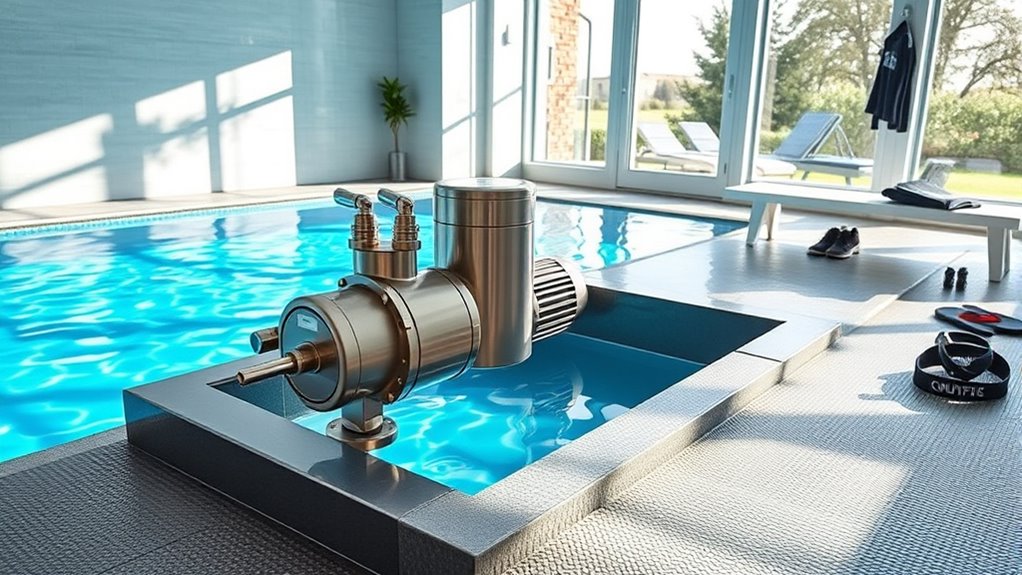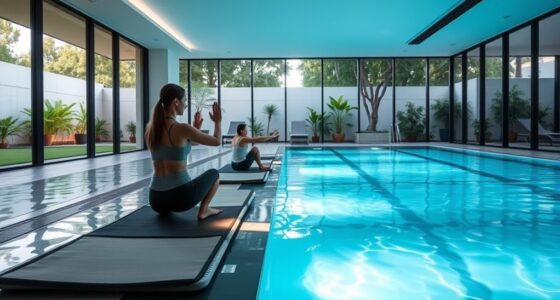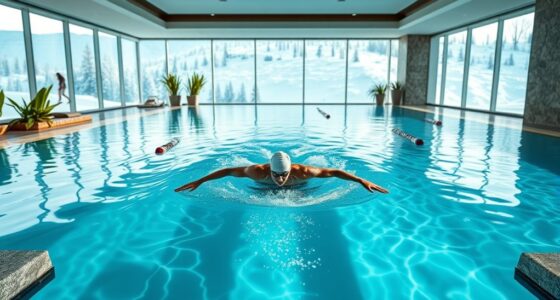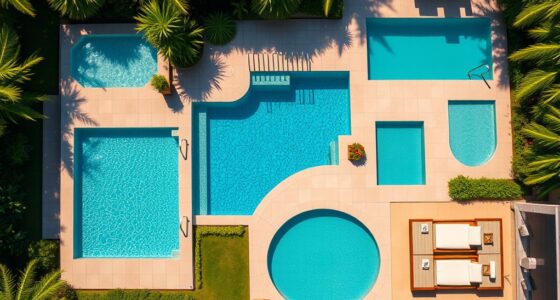Building a DIY swim current system is a smart, budget-friendly alternative to buying an endless pool. You can use hydraulic mechanisms and motorized paddles to create a steady, adjustable water flow that mimics natural currents. Control the water speed with simple pumps and valves, and customize the setup to fit your space and training goals. With some guidance, you’ll discover how to design a safe, effective system that saves money and fits your needs perfectly.
Key Takeaways
- DIY swim current systems are cost-effective alternatives that customize to available space and budget constraints.
- Hydraulic pumps and motorized paddles create adjustable water flow for realistic swimming resistance.
- System setup involves water recirculation with flow control valves to fine-tune current strength.
- Use durable, corrosion-resistant materials and secure waterproof components to ensure safety and longevity.
- Design flexibility allows for custom lanes or chambers, adapting the system for specific training needs without complex electronics.
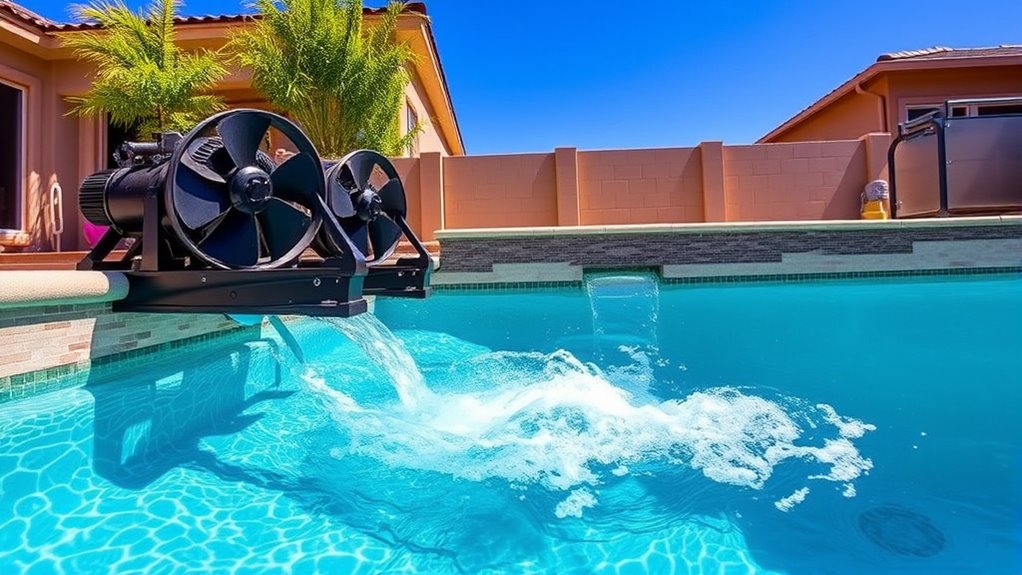
Creating your own swim current system can be a cost-effective way to turn any pool into a convenient training spot. Instead of investing in expensive commercial options like an endless pool, you can build a system tailored to your space and budget. One of the simplest approaches involves utilizing hydraulic mechanisms and motorized paddles to generate a steady stream of water that simulates open water swimming. Hydraulic systems are reliable and relatively easy to set up, providing consistent flow without requiring complex electrical components. They work by harnessing pressurized water, which can be directed through pipes or channels to create a strong current that pushes against you as you swim. When combined with motorized paddles—small, powered devices that mimic the natural movement of swimming strokes—you can enhance water flow and create more realistic resistance training conditions.
To start, you’ll need to contemplate the placement of the hydraulic mechanisms. Installing a pump system that connects to a series of pipes or hoses allows you to control the water flow rate. The pump’s capacity determines the strength of your swim current, so choose one that matches your desired intensity. Motorized paddles can be attached to the outlet of your hydraulic system or positioned within the pool to generate turbulence. These paddles are driven by small motors that turn blades or fins, creating a continuous flow of water. They’re adjustable, so you can increase or decrease resistance depending on your training needs. For safety and efficiency, ensure the paddles are waterproof and securely mounted to prevent accidents.
Building your own system also means customizing the size and shape of the flow channel. You might construct a dedicated lane or a side chamber where water is recirculated through your hydraulic setup. Incorporate flow control valves to fine-tune the water speed, making your system adaptable for different workouts. If you’re comfortable with basic plumbing, you can set up a closed-loop system that recycles the water, reducing the need for constant water refilling and lowering operational costs. Using durable materials like PVC pipes and corrosion-resistant fittings ensures your system remains functional over time.
Frequently Asked Questions
What Safety Precautions Should I Consider When Building My System?
When building your swim current system, safety is key. You should always wear appropriate safety gear, like goggles and a life vest, during installation and use. Make sure your system has an emergency shutdown feature accessible at all times to quickly stop the current if needed. Regularly inspect your equipment for damage or wear, and keep a phone nearby in case you need to call for help.
Can I Customize the Speed and Resistance Levels Easily?
Did you know that most swim current systems offer over 50% variability in speed? You can easily customize the speed and resistance levels with adjustable controls, making your workout more effective and tailored to your needs. With simple adjustments, you can increase resistance for a tougher swim or lower it for recovery. These systems are designed for user-friendly variable speed and resistance adjustments, so you get a personalized swim experience every time.
What Is the Average Cost Compared to Commercial Systems?
You might wonder about the cost comparison between DIY swim current systems and commercial options. Generally, DIY setups are more affordable, often costing a fraction of commercial systems. Their affordability analysis shows you save on installation and equipment expenses, making them accessible for most budgets. While commercial systems offer advanced features, DIY alternatives provide a cost-effective way to enjoy a swim current without breaking the bank.
How Much Space Is Required for Installation?
When considering your DIY swim current system, space requirements and installation considerations are key. You’ll need enough room for the unit itself and safe access for maintenance. Typically, allocate at least 8-10 feet of width and 10-15 feet of length, depending on the system’s size. Confirm your space can support the weight and power needs. Proper planning helps you avoid cramped setups and makes installation smoother and safer.
Are There Any Maintenance Requirements for DIY Systems?
You’ll need to regularly maintain your DIY swim current system, including pool cleaning to prevent algae and debris buildup. Check and clean the filtration system often, and guarantee the electrical wiring stays secure and safe. Routine inspections help prevent malfunctions. By staying on top of these maintenance tasks, you’ll keep your system running smoothly, ensuring safe, effective workouts without unexpected issues.
Conclusion
Building your own swim current system offers freedom and customization, turning your backyard into a personal oasis. While it may lack the sleek, endless pool’s polished perfection, it provides the satisfaction of creating something with your own hands. You get the thrill of innovation paired with the challenge of DIY. In the end, it’s not just about swimming against a current, but about crafting a unique space where effort meets reward, making every swim truly your own.
